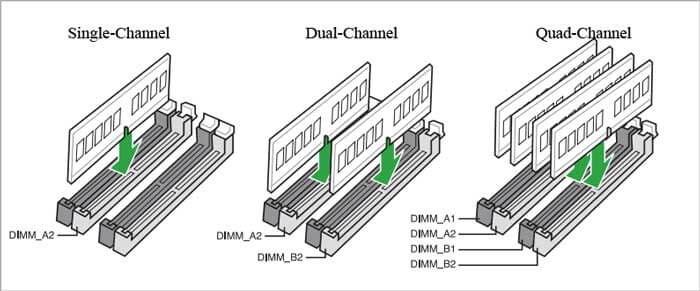RAM Buying Guide | How to Choose RAM for Your Computer

RAM, or random-access memory, is a hardware device that can temporarily store data from the operating system and applications in current use for the processor to access easily. It is one of the most significant parts of a computer. So, whether you are building a PC or replacing a new RAM for a laptop, it is vitally necessary for you to pay attention to choose the right RAM. In this post, we will walk you through how to choose the right RAM for your computer including desktop and laptop.
1. Desktop or Laptop

First and foremost, you should pay attention to checking whether the memory module is for a laptop or desktop when buying a RAM. Laptops and desktops use different types of RAM, which are not interchangeable. The laptop supports RAM of SO-DIMM (Small Outline Dual In-Line Memory Module) module while DIMM (Dual In-Line Memory Module) module RAM is used on the desktop. Just as their names imply, SO-DIMM is simply a smaller version of DIMM designed for use on the laptop. They have different lengths and numbers of pins, so it is not hard to distinguish.
2. Compatibility with motherboard

When you are selecting a RAM, you must check out the compatibility between RAM and motherboard. The motherboard has limitations on many key factors of memory such as DDR generations, maximum capacity, and frequency. Namely, you can't use a newer generation DDR memory in the motherboard that supports the older DDR generation and vice versa. You shouldn't choose a RAM whose capacity is larger than the maximum capacity that the motherboard supports. So is the frequency. Besides, it's also necessary for you to note how many slots your motherboard has. Take B360M-D3H motherboard (shown above) as an example, it supports up to 64GB of system memory so you can only choose less than 64GB of memory. It supports DDR4 2666/2400/2133 memory modules and you can only choose these types of memory.
3. DDR and Frequency
| Memory Type | Main Frequency (Transfer rate) |
|---|---|
| DDR | 333、400、533 MHz |
| DDR2 | 533、667、800、1066 MHz |
| DDR3 | 1066、1333、1600、1866、2400 MHz |
| DDR4 | 2133、2400、2666、3000、3200 MHz |
Frequency is one of the most significant factors of RAM. It is measured in MHz and typically follows by the DDR generation in the RAM spec. For example, DDR3-2133 RAM runs at a frequency of 2133 MHz. The frequency of RAM determines the communication speed with a motherboard, which reflects on the performance. Different DDR generations of memory support different ranges of transfer rates. The selection of DDR generation depends on the motherboard. The mainstream memory is DDR4 memory at present. As for frequency, typically, a higher frequency of memory is always better. The memory of 2400 or 2666 MHz is a good fit for mainstream computers. However, one thing mentioned above you have to keep in mind is that you shouldn't choose a RAM whose frequency is higher than that of the motherboard supports.
4. Capacity of RAM
| Purpose | Capacity |
|---|---|
| Basic Home (browsing the web and watching videos) | 4GB |
| Budget-friendly | 4GB - 8GB |
| Mainstream (for most computer use) | 8GB - 16GB |
| High-end (gaming, video and graphic editing) | 16GB or more |
The capacity of RAM is also one of the key factors when choosing a RAM. How much RAM is enough? It depends on what your computer is used for. Typically, 16GB of RAM is a choice for the mainstream computer at present. For less budget, 8GB of RAM is also a pretty good choice. If you are intended to build a basic computer for general use like browsing the web, doing word processing, and watching videos, it is recommended to choose 4GB of RAM. If you are building a high-end computer for gaming, video editing, and graphics design, you may need 16GB or more of RAM to run your computer smoothly.
5. Channels of RAM

Multi-channel mode for RAM seems to be the choice of most people. It is a technology that increases the data transfer rate by adding more channels of communication. On one hand, multi-channel memory architecture doubles the memory bandwidth when compared to single-channel mode, which can improve the performance to some extent. On the other hand, once one of the RAM is broken, you can still use the other one in multi-channel mode. So, the multi-channel mode for RAM is a pretty good choice indeed. For example, if you choose 16GB of RAM, it would be better to use two 8GB of RAMs in dual channels mode.
Tips: If you are intended to use RAM in multi-channel mode, though the RAM in different models can be used in conjunction, it is recommended to use the same RAMs to avoid the issues of compatibility.
Closing thoughts
The factors mentioned above are all worth considering when choosing a RAM. In addition, there are some aspects such as brand, XMP, price, timings, and latency that also need to be taken into consideration. Totally speaking, you need to choose a suitable RAM for your computer to avoid it becoming a bottleneck or excess of performance.


















